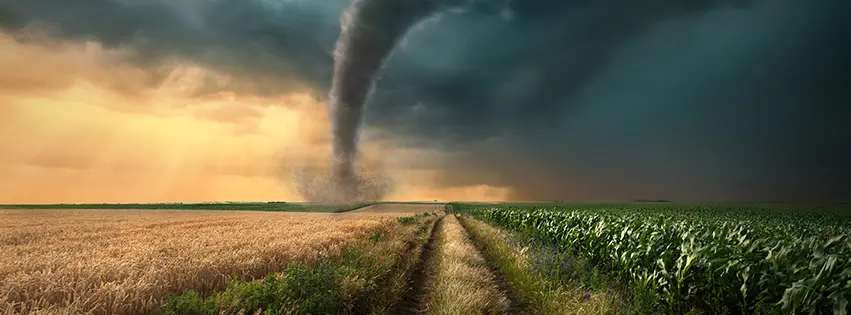
Tornadoes: What To Look For and How To Stay Safe
Spring brings many great things in Tennessee, but it's also a peak time for tornadoes. This is why it's important to know how to keep your family and furry friends safe in the event of a tornado, which can occur most frequently in March, April, and May in Tennessee followed by a second tornado season in November and December.
Watches And Warnings: What's The Difference?
Knowing the difference between a tornado watch and a tornado warning is critical. A tornado watch means that a tornado is possible, and a tornado warning means a tornado has already been spotted or will occur soon. If you hear a tornado warning, seek shelter immediately. Although this may sound a little confusing, there are important signs to look out for that will indicate the level of urgency or chance of a tornado.
Tornado Watches:
A tornado watch will be issued by the National Weather Service when atmospheric conditions are favorable for tornado formation in that particular area or region. At this point, the weather conditions are conducive to a tornado development, but no tornado has actually been spotted yet. Although no sighting of a tornado is evident yet, it's still important to be prepared to have a plan and seek shelter if necessary.
Signs to look out for:
Dark and/or greenish skies, often accompanied by a stillness or eerie calmness in the atmosphere
Increasing wind speeds and changes in wind direction
Rapidly changing weather conditions, including shifts in temperature and humidity
Distant rumbling or continuous thunder
Formation of large, towering cumulonimbus clouds that may exhibit rotation or a "wall cloud" appearance
Flashes of lightning even before the storm reaches your location
Reports of severe thunderstorms or tornadoes in nearby areas
Enhanced radar signatures indicating the potential for severe weather, including rotation within storm cells
Local emergency sirens or alerts activated by authorities
Increased radio or television coverage discussing the tornado threat and providing safety instructions
Tornado Warnings:
A warning is more urgent and immediate. This will also be issued by the National Weather Service in the event that a tornado is actually detected by a radar or visually confirmed. The area is in imminent danger and action will need to be taken as soon as possible.
Signs to look out for:
Rotation in the clouds, often appearing as a funnel-shaped cloud or a visible rotating column
A loud, continuous roar or rumble, similar to the sound of a freight train
Rapidly changing or intense wind patterns, with swirling winds that may produce debris or a visible dust cloud
Darkened or obscured skies, with low visibility due to heavy rain, hail, or flying debris
Severe and sudden thunderstorm activity, including intense lightning, heavy rainfall, and large hailstones
Local emergency sirens sounding, indicating an immediate threat of a tornado in the area
Reports or confirmed sightings of a tornado from storm spotters, emergency responders, or trained weather observers
Loss of power or disruptions in communication, as tornadoes can damage electrical infrastructure and communication systems
Tornado sirens are used in just about every state to alert you that a tornado has been spotted in your area. Pay attention to these warnings but also have more than one means of finding out about weather conditions. Always keep a weather radio with a battery backup in your home or a weather app on your smartphone with notifications turned on for severe weather and warnings.
Tornado And Safety Misconceptions:
With all the public information swirling around by word of mouth or the internet, it's important to note there are some common misconceptions surrounding tornados and the safety steps to take in the event of one:
Tornado Misconceptions:
They always appear as a visible funnel cloud.
False. Tornadoes can be obscured by heavy rain, low-lying clouds, or darkness. They may not always have a visible funnel-shaped cloud, making it essential to rely on other indicators, such as severe weather warnings and local emergency notifications.
They only occur in spring and summer.
False. While tornadoes are more prevalent in spring and summer, they can happen throughout the year. Tornadoes can occur during any season if the atmospheric conditions are conducive to their formation.
They only happen during the daytime.
False. Tornadoes can occur at any time of day or night. Although they are more commonly associated with daytime heating and atmospheric instability, they can strike during the night when people may be less aware or prepared.
They always travel in a straight line.
False. Tornadoes can exhibit erratic and unpredictable paths. They can change direction, shift back and forth, and "skip" over areas, making it challenging to anticipate their movements accurately.
Tornadoes only occur in certain regions or states.
False. While tornadoes are more common in certain areas, they can happen in many parts of the world, including countries outside of the traditional "Tornado Alley" in the United States.
Tornadoes can't happen in cities.
False. Tornadoes can and do occur in urban areas. Tall buildings and concrete landscapes can create wind patterns that can enhance tornado formation and intensify their impacts.
Safety Misconceptions:
Opening windows will prevent your house from exploding during a tornado.
False. Opening windows is unnecessary and can actually be dangerous. Tornadoes create intense, rapidly changing air pressure, and opening windows can allow damaging winds and debris into your home.
Overpasses are a safe place to seek shelter during a tornado.
False. Overpasses are not safe during a tornado. They can create wind tunnels and increased wind speeds, making them extremely dangerous places to be during a tornado. It is best to find a sturdy, low-lying shelter or a designated storm shelter.
Where To Shelter In The Event Of A Tornado
In the event of a tornado warning, you'll be required to have a plan and take immediate action. Use the following tips when seeking shelter:
Seek immediate shelter in a basement, storm shelter, bathroom, closet or inner hallway.
Make sure the designated area is an interior room that is the lowest level of your home with no exterior doors, windows, or walls.
Cover yourself and loved ones with pillows and blankets to protect from flying debris.
If you live in a mobile home, seek shelter in a nearby sturdy building or neighbor's home.
If you're in a car, get home as quickly as possible and seek shelter. If you don't have time to do this, get out of your car and hunker down in a ditch. Stay ducked down and cover your head until the tornado passes. If you must remain in your car, buckle your seatbelt and stay crouched down away from the windows.
Never seek shelter in an underpass.
Prepare For A Tornado Before It Occurs
Ideally, you'll have an idea of what exactly to do in the event of a tornado before it happens. Even if you think there's a slim chance of it happening in your area, it's vital that you have a plan ready to put into action if necessary. We recommend taking the following steps:
Develop a tornado emergency plan for your household, including identifying a safe shelter area in your home where you can seek refuge during a tornado. This area should be a small, windowless interior room on the lowest level of your home, such as a basement or a designated storm shelter.
Ensure all family members are aware of the tornado emergency plan and know how to access the designated safe shelter area quickly. Practice tornado drills regularly, especially if you have young children, to familiarize everyone with the process.
Create an emergency kit that includes essential supplies such as non-perishable food, water, a battery-powered or hand-cranked radio, flashlights, extra batteries, a first aid kit, a whistle, blankets, and a basic toolkit.
Stay informed about weather conditions by monitoring reliable sources of information, such as a weather radio, local news, or a trusted weather app on your smartphone.
Consider purchasing a NOAA Weather Radio that can provide immediate alerts and updates regarding severe weather in your area.
Secure outdoor items that could become projectiles during high winds, such as patio furniture, trash cans, and garden tools. Store them in a safe place or anchor them down.
Trim trees and branches near your home that could potentially fall and cause damage during a tornado.
Ensure that your insurance coverage is up to date and provides adequate protection for your property and belongings in the event of tornado-related damage.
Have a plan for communication with family members during and after a tornado. Establish a designated contact person outside the affected area who can serve as a point of contact for all family members to check in and provide updates.
Stay informed about community warning systems and understand the different siren signals and alerts used in your area.
Plan Ahead Of Time To Stay Safe In The Event Of A Tornado
Of course, in the event of weather conditions such as these, there is always the potential of serious damage that can occur to your home. While your safety and well-being is the most important, you will not always be able to control what may happen to your home or the belongings within it. That's why it's important to make sure your home insurance is suited for even the most unlikely of circumstances. Farm Bureau Insurance provides coverage to help you stay prepared for a weather event like a tornado. Contact Farm Bureau Insurance today, or go see your local agent to discuss your coverage options.
Tennessee Insurance: Read More

What is an Auto Deductible?
October 9, 2024
When it comes to auto insurance, understanding the terminology is crucial to making informed decisions about your coverage. One term that often comes up in discussions about car insurance is the “auto deductible.” Read more

What Is Business Insurance?
December 10, 2024
Whether you are a small business owner or a seasoned entrepreneur, having the right insurance coverage is crucial to protect your assets and mitigate various risks. In this article, we aim to provide you with an in-depth understanding of what business insurance is, its significance, and how it can contribute to your company's success. Read more

What's The Difference Between Term and Whole Life Insurance?
May 31, 2024
Life insurance is a crucial aspect of financial planning, offering peace of mind and financial security for your loved ones in the face of life's uncertainties. In this article, we'll explore the key differences between these two options. Read more
